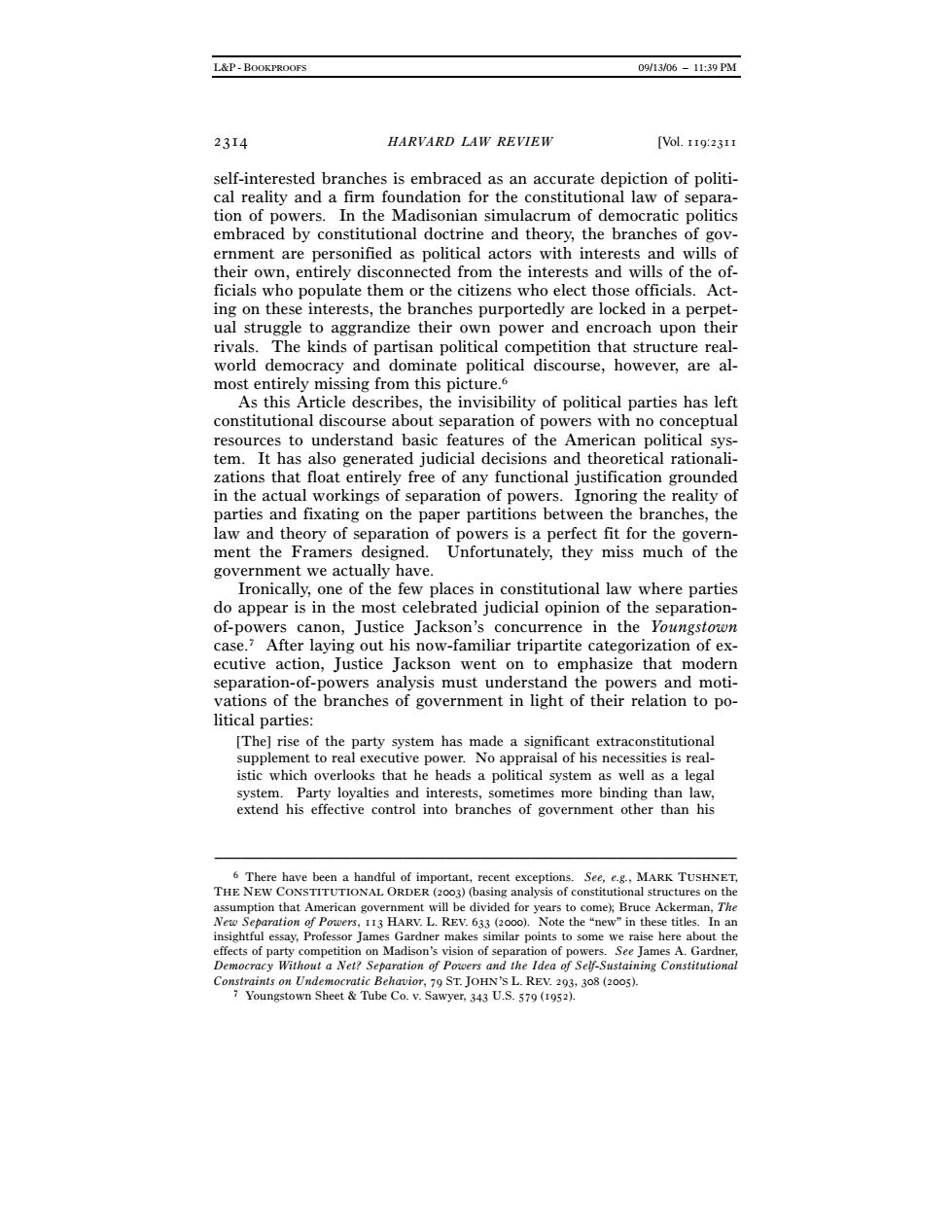正在加载图片...

L&P-BOOKPROOFS 09/13/06-11:39PM 23I4 HARVARD LAW REVIEW [Vol.I19:2311 self-interested branches is embraced as an accurate depiction of politi- cal reality and a firm foundation for the constitutional law of separa- tion of powers.In the Madisonian simulacrum of democratic politics embraced by constitutional doctrine and theory,the branches of gov- ernment are personified as political actors with interests and wills of their own,entirely disconnected from the interests and wills of the of- ficials who populate them or the citizens who elect those officials.Act- ing on these interests,the branches purportedly are locked in a perpet- ual struggle to aggrandize their own power and encroach upon their rivals.The kinds of partisan political competition that structure real- world democracy and dominate political discourse,however,are al- most entirely missing from this picture.6 As this Article describes,the invisibility of political parties has left constitutional discourse about separation of powers with no conceptual resources to understand basic features of the American political sys- tem.It has also generated judicial decisions and theoretical rationali- zations that float entirely free of any functional justification grounded in the actual workings of separation of powers.Ignoring the reality of parties and fixating on the paper partitions between the branches,the law and theory of separation of powers is a perfect fit for the govern- ment the Framers designed.Unfortunately,they miss much of the government we actually have. Ironically,one of the few places in constitutional law where parties do appear is in the most celebrated judicial opinion of the separation- of-powers canon,Justice Jackson's concurrence in the Youngstown case.?After laying out his now-familiar tripartite categorization of ex- ecutive action,Justice Jackson went on to emphasize that modern separation-of-powers analysis must understand the powers and moti- vations of the branches of government in light of their relation to po- litical parties: [The]rise of the party system has made a significant extraconstitutional supplement to real executive power.No appraisal of his necessities is real- istic which overlooks that he heads a political system as well as a legal system.Party loyalties and interests,sometimes more binding than law, extend his effective control into branches of government other than his 6 There have been a handful of important,recent exceptions.See,e.g.,MARK TUSHNET, THE NEW CONSTITUTIONAL ORDER (2003)(basing analysis of constitutional structures on the assumption that American government will be divided for years to come);Bruce Ackerman,The New Separation of Powers,I13 HARV.L.REV.633 (2000).Note the "new"in these titles.In an insightful essay,Professor James Gardner makes similar points to some we raise here about the effects of party competition on Madison's vision of separation of powers.See James A.Gardner Democracy Without a Net?Separation of Powers and the Idea of Self-Sustaining Constitutional Constraints on Undemocratic Behavior,79ST.JOHN'S L.REV.293,308 (2005). 7 Youngstown Sheet Tube Co.v.Sawyer,343 U.S.579(1952).L&P - BOOKPROOFS 09/13/06 – 11:39 PM 2314 HARVARD LAW REVIEW [Vol. 119:2311 self-interested branches is embraced as an accurate depiction of political reality and a firm foundation for the constitutional law of separation of powers. In the Madisonian simulacrum of democratic politics embraced by constitutional doctrine and theory, the branches of government are personified as political actors with interests and wills of their own, entirely disconnected from the interests and wills of the officials who populate them or the citizens who elect those officials. Acting on these interests, the branches purportedly are locked in a perpetual struggle to aggrandize their own power and encroach upon their rivals. The kinds of partisan political competition that structure realworld democracy and dominate political discourse, however, are almost entirely missing from this picture.6 As this Article describes, the invisibility of political parties has left constitutional discourse about separation of powers with no conceptual resources to understand basic features of the American political system. It has also generated judicial decisions and theoretical rationalizations that float entirely free of any functional justification grounded in the actual workings of separation of powers. Ignoring the reality of parties and fixating on the paper partitions between the branches, the law and theory of separation of powers is a perfect fit for the government the Framers designed. Unfortunately, they miss much of the government we actually have. Ironically, one of the few places in constitutional law where parties do appear is in the most celebrated judicial opinion of the separationof-powers canon, Justice Jackson’s concurrence in the Youngstown case.7 After laying out his now-familiar tripartite categorization of executive action, Justice Jackson went on to emphasize that modern separation-of-powers analysis must understand the powers and motivations of the branches of government in light of their relation to political parties: [The] rise of the party system has made a significant extraconstitutional supplement to real executive power. No appraisal of his necessities is realistic which overlooks that he heads a political system as well as a legal system. Party loyalties and interests, sometimes more binding than law, extend his effective control into branches of government other than his ––––––––––––––––––––––––––––––––––––––––––––––––––––––––––––– 6 There have been a handful of important, recent exceptions. See, e.g., MARK TUSHNET, THE NEW CONSTITUTIONAL ORDER (2003) (basing analysis of constitutional structures on the assumption that American government will be divided for years to come); Bruce Ackerman, The New Separation of Powers, 113 HARV. L. REV. 633 (2000). Note the “new” in these titles. In an insightful essay, Professor James Gardner makes similar points to some we raise here about the effects of party competition on Madison’s vision of separation of powers. See James A. Gardner, Democracy Without a Net? Separation of Powers and the Idea of Self-Sustaining Constitutional Constraints on Undemocratic Behavior, 79 ST. JOHN’S L. REV. 293, 308 (2005). 7 Youngstown Sheet & Tube Co. v. Sawyer, 343 U.S. 579 (1952)